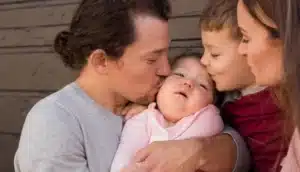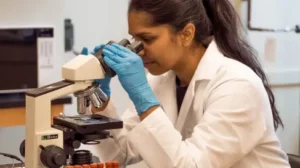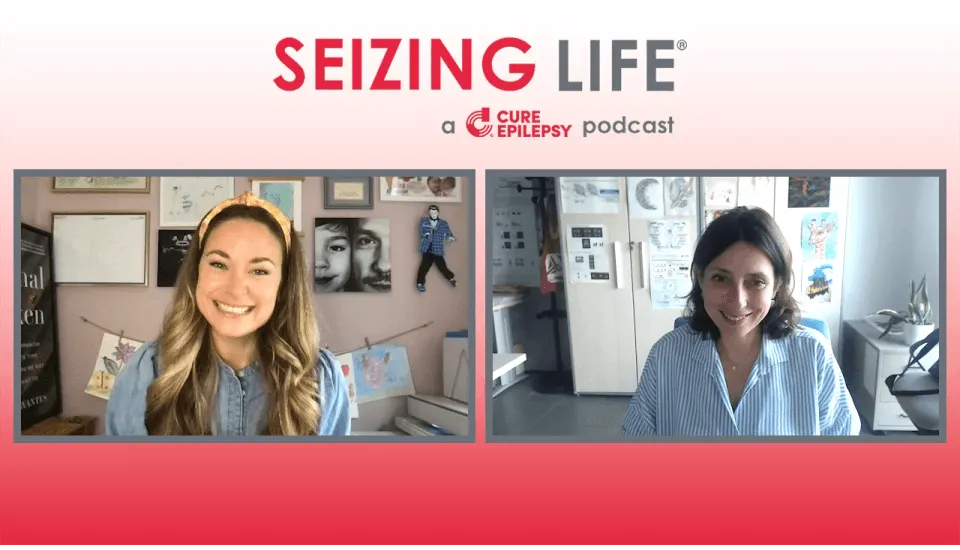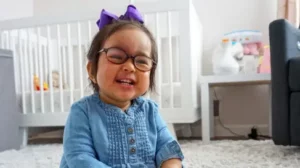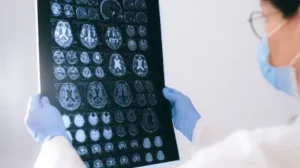Infantile Spasms. The journey from Diagnosis to Treatment
Episode Overview
This week on Seizing Life® Kate Kostolansky shares her daughter Charlotte’s infantile spasms diagnosis and treatment journey, and explains how these experiences inspired a children’s book designed to help newly-diagnosed families and those around them better understand infantile spasms.
Kate Kostolansky first noticed her daughter Charlotte repeatedly making a strange movement shortly before Charlotte’s second birthday. After sharing a video of the movement with Charlotte’s pediatrician, Kate was reassured that it was nothing to be concerned about. However, the strange movement continued, and, as an admittedly nervous first-time mother, Kate requested a referral to a neurologist. The neurologist quickly diagnosed infantile spasms with a late onset at nearly two years old, confirming the diagnosis with an EEG. Kate shares the treatment journey that followed, its impacts on Charlotte’s physical and cognitive development, and the early intervention therapies that Charlotte underwent to address developmental delays. Kate explains how a second round of treatment finally eliminated the spasms and provides an update on Charlotte’s health situation today. Finally, Kate shares how Charlotte’s journey spurred her to write a children’s book entitled “Char Bear Keeps Dancing” and her plans to get the book into hospitals and ultimately in the hands of newly diagnosed families to help them navigate their child’s infantile spasms diagnosis and treatment.
You can learn more about Char Bear Keeps Dancing here.
Episode Transcript
Kelly Cervantes: Hi, I’m Kelly Cervantes and this is Seizing Life, a biweekly podcast produced by Cure Epilepsy. Today, I’m happy to welcome Kate Kostolansky to the podcast. Kate’s daughter, Charlotte, was diagnosed with infantile spasms just before her second birthday, which is a late onset for IS. Kate is here today to share Charlotte’s journey and progress and to tell us about a children’s book she was inspired to write. Kate, thank you so much for joining us today. I would love to hear about your daughter, Charlotte. What does she like? How old is she? Give us the Charlotte rundown.
Kate Kostolansky: Yeah, well thanks for having me. So Charlotte is our first baby. She is just all of the things. She is happy. She is silly. She has quite a flare for dramatic, so we joke that she’s going to be a great actress one day. But she has such a lovable and big energy about her. She just is so, so happy.
Kelly Cervantes: And how old is she now?
Kate Kostolansky: She just turned three. She turned three in June and we just celebrated her little brother, Teddy’s, first birthday this past week.
Kelly Cervantes: Oh my goodness. A big sister. I love it.
Kate Kostolansky: Yes. A bossy big sister for sure.
Kelly Cervantes: I know a thing or two about that, being a bossy big sister. So tell me a little bit about Charlotte’s journey with epilepsy and what sort of tipped you off that something wasn’t quite right. Because it’s really only been within this last year that you’ve been navigating this.
Kate Kostolansky: So Charlotte developed normally until she was two, and right around that time, it was right before her second birthday, we noticed her doing this strange, it kind of looked like a startle reflex. Her arms would go up and there was something just unsettling about it to me that it seemed involuntary. But it would last only a few seconds and then she’d be perfectly fine. So I took a video of it and I brought it up at her second year well check with her pediatrician and she actually did it in the room with the pediatrician, did that same thing. And the pediatrician reassured us that she’s met all of her milestones and she wasn’t concerned with the movement and, of course, that’s what I wanted to hear so that was kind of reassuring.
And then I went home and she still was doing it. It was usually after nap time, but it still just didn’t sit right with me. So I called back and I was that annoying mom and asked if she could give me a referral to a pediatric neurologist just for peace of mind. And she was wonderful and said, of course, and thought very much that it was going to just be for peace of mind. The irony now is that it wasn’t, but that was the first interaction that we had kind of thinking something was off.
Kelly Cervantes: So you said that she was developing normally up to this point, how long did it take you to get in to see the pediatric neurologist?
Kate Kostolansky: So I called right away and he was great. We did a talk over the phone and I’m so thankful that he was, most places you don’t talk to the doctor. You talk to somebody scheduling. And because we’re in a small town in New Hampshire, he actually talked to me. He said to send over some videos and then he got us in pretty quickly and as soon as he saw the videos, he thought infantile spasms. It’s so counterintuitive because you see this small movement and you come to later realize what the serious implications are, but at the time it all felt very dramatic. Like, sure, I wanted to look into this, but the neurologist went from looking at the video to scheduling an EEG and telling us that if it was confirmed, all of the things that lie ahead that felt like a very stark contrast to the reassurance we had just received. So that was really our first interaction with any sort of understanding of what this was.
Kelly Cervantes: Now what were you told about infantile spasms and were you given any ideas of prognosis? When my daughter was diagnosed with infantile spasms, I had certainly never heard of it before. So the first thing I do of course is Google it and then it’s terrifying and as it should be. Thankfully the neurologist that you saw took it seriously because it is an emergency. But it does, you’re right, it’s these small movements and it’s so hard to reconcile that with the emergency and the potential damage that it is. So I wonder what were you told along the way as you were navigating this in the early days?
Kate Kostolansky: Yeah, and like you said, it’s a hard balance because you go online and he told us, “Don’t Google this.” And, of course, you do because you don’t know anything and I hadn’t heard of it and she’s our first baby. We took every class under the sun, read all the books. So we Googled it and it does, the prognosis is horrible. It’s so terrifying. And it’s just like you said, it’s that balance of, yeah, it is that urgent, but at the same time there’s only very negative and it’s mostly outdated information that we found. So there weren’t great resources until we really were at a care team I think when we went to Boston Children’s. And that was the first time that I felt like we kind of had a team in place that was looking at that.
Kelly Cervantes: Now, I want to touch on something else because Charlotte was two when she started exhibiting signs for infantile spasms, which is very late. Typically, infantile spasms shows within the first year, even within six to nine months. Three to nine months is really when it presents the most. So Adelaide, my daughter, had infantile spasms when we would get rid of it and then it would come back and it would come back. And the last time it came back she was over two years old and we had a hard time getting medication because the indication for IS is only up to two years old. So talk to us about that and any of the challenges that you faced or what you were told because she was two, which really is late for it to show up.
Kate Kostolansky: And IS is rare. It’s three in 10,000 and 90% of those are, within the first year the children are diagnosed. So we were looking at epilepsy. As you know all too well, it’s not linear, it doesn’t make sense and it is frustrating. So we were the lucky and unlucky in that she was in a smaller percentage of an already small number. And on one hand that made it really hard to find when there’s already not a lot of information in data and all the statistics that you want as a parent that was lacking enormously for her. So she was 23 months at onset and that’s why they were able to still consider it. But all of those same things that it was confusing even for pharmacists filling her prescriptions because she was older than most.
So it does happen, but there aren’t that many cases. And then when there’s a better prognosis, maybe they’ve met milestones. It’s crazy. I’ve talked to so many moms that then their kids aren’t followed because they end up doing well or getting spasms under control. And so there is just such a lack of data and statistics around infantile spasms in general. It’s just not enough.
Kelly Cervantes: Yeah, I agree with you there.
Brandon: Hi, this is Brandon from Cure Epilepsy. Have you or a loved one been recently diagnosed with epilepsy? Are you looking for more information about epilepsy and available treatment options? Go to www.cureepilepsy.org/for-patients to get resources and information about epilepsy. Now back to Seizing Life.
Kelly Cervantes: Now, you mentioned that you were able to get to Boston Children’s where they were able to give you more specialized treatment for the IS. What was the treatment that was prescribed initially?
Kate Kostolansky: We started with steroids. And if you look at most websites, it tells you that ACTH is the first line treatment and that’s what we assumed we would start with. And Children’s is kind of always at the forefront of the studies and they actually found that Prednisolone was a better option and I mean it’s hard. You have to listen to the professionals, but that was awful. That was heartbreaking to go through. We did two rounds of that and that was really, really hard.
Kelly Cervantes: So explain to people because, I mean, the times that Adelaide was on steroids was probably some of the worst of her life. Explain what that’s like so people can understand what that means, because people hear steroids and they’re like, they seem so commonplace. My husband is a singer, so sometimes he takes a steroid if his voice is feeling tired. But these steroids are a little bit different.
Kate Kostolansky: And a big amount for little, little people. Because like you said, I was like, oh, steroids, okay, we can do this. And to watch what it steals from them, you have to believe in the greater goal of it. But as you’re watching it, it was definitely the darkest times. They’re so exhausted, they’re so uncomfortable. The way I describe it to people is, Charlotte was a shell of who she is, and it was heart-wrenching as a parent. And when we had to do it a second time, knowing how bad it was going to be, was tough. The second time we added Vigabatrin and the possible side effects with that, as it was explained to us, are possible vision loss and you’re hit with a truck of all of these things and then there’s potential vision loss with this experimental drug and at first, we didn’t feel comfortable with that.
And then as it goes on and you see how much the spasms are stealing from them in a different way, you’re like, I’ll give them anything. And they have to tell you those side effects, but it is so well-managed. She saw an ophthalmologist so many times and now, perspective is everything, but I wish we had done that from the beginning. And that has, thankfully, knock on wood because I’m a little superstitious, that was what ended up getting spasm control for her. So that was the miracle combo.
Kelly Cervantes: And there’s, in a lot of recent studies, what they’re showing is that combination, whether it’s ACTH or Prednisolone with Vigabatrin, the two of them together seems to provide the best outcomes. But it is, it’s scary. You’re talking about vision loss and you’re putting your child on this steroid and they get all puffy and they don’t even look like themselves anymore and they’re crying. But the reverse of that, what the infantile spasms is taking these milestones away, it’s taking their smiles and their personality, and if there isn’t a regression, it’s at least halting development. Did you see any regressions or stalled out development in Charlotte during that time?
Kate Kostolansky: Yeah. So her being older, she was already walking and talking and I thought that she was kind of speech-delayed, but I was by all accounts at this point, a nervous first time mom that was wanting her to be at the beginning of every milestone on the AP guidelines. And in hindsight, it really was the beginning of at least a plateau. And I say to parents that I’ve talked to since that it’s so hard once you start the medication because you had your baby that was smiling, laughing, doing all the things that you said, and then you start them on this medication for something that looks not that serious, it’s just a little spasm, and it feels so much worse. It feels like this is what’s stopping their development and this is what’s halting everything.
And it’s so much easier to say being on the other side, because at the time we weren’t making any progress and we did the therapy, early intervention, everything under the sun, and you don’t know if it’s working, getting anywhere or doing anything because you’re not seeing anything. It was a complete pause of everything. And the only upside is, if we hadn’t gone through the treatment, then it would’ve been a regression. And you don’t know that until you’re in it, but it’s hard to make that jump to do it, but otherwise, it’s going to be so much worse and that’s terrifying.
Kelly Cervantes: Yeah, absolutely. And so you mentioned that you did the first round of steroids and it didn’t work or the seizures came back, and then you did the second round with the Vigabatrin and that has worked. How is Charlotte doing today? So I’m knocking on wood here-
Kate Kostolansky: Thank you.
Kelly Cervantes: … I hate saying any of that stuff, but she is seizure-free at the moment. How is she doing developmentally? A big old three-year-old now.
Kate Kostolansky: Yeah. So at three, early intervention and I’m sure there’s a million appointments that you have, a million therapies, everything, and you kind of just are used to them. And it was really sad when we were ending our early intervention because they’re just so wonderful. Everything they do. I have a whole new appreciation. It’s so fascinating. And she was evaluated at age appropriate development and I don’t know, we had been so going through the motions and she had a few clear EEGs, which was a huge win. And you kind of stop focusing on the development when you just want them to be back to healthy and happy and everything else just seems not as important.
So to get that was like, oh my gosh, that was something we never thought that we would hear. And at the same time, I say that with a lot of compassion and my heart breaks that I know what it’s like when you hear that and you’re still seeing the spasms on your child and nothing’s working. And we were close to failing two drugs. And after that, if you fail to, then you’re presumed to continue to fail them. And that is the reality for too many families. And it really only made me more passionate that this is something that no family should go through.
Kelly Cervantes: Kate, you bring up something really important that certainly hits home for me. We never got control of Adelaide’s spasms. But I think that stories like yours, like Charlotte’s, are so important because when families are researching infantile spasms, they find my family’s story and it is tragic and horrible, but that is not everyone’s story. And I want people to know that there is hope, that there is this world where there are treatments that can beat it, which is why I think that your story is so important and that it needs to be shared because there are children who come out on the other side.
I do want to, and I know that you are aware of this, I’m not telling you anything you don’t know, but any child that is diagnosed with infantile spasms, even if they are able to get rid of it, has a chance of a different type of seizure coming back or developing a different type of epilepsy. And so it is always something that you have to be aware of. While Charlotte is going to go on and lead this healthy typical life, that potential epilepsy diagnosis is going to be there and so I do want to emphasize that.
Kate Kostolansky: You’re never safe. You’re never safe.
Kelly Cervantes: No. And it sucks. But I think it’s one of the reasons that all of, for example, the infantile spasms research that cure has been working on is so important because these treatments are not cures. They are treatments and they can get rid of the hypsarrhythmia that comes with the infantile spasms, this bizarre brainwave pattern, and the seizures, but they are not curing whatever caused them in the first place. And so while I am ecstatic for you and your family and the hope that your story can bring to people, I do want to make sure that there is still an urgency that people feel that more data and more information and more research is so desperately needed.
Which brings me to this incredible book that you’ve written, which I hope does just that and raises incredible awareness. Tell us about Char Bear Keeps Dancing.
Kate Kostolansky: Yeah, so Charlotte being older, she was in preschool and we wanted to make sure that, especially since we didn’t have spasm control yet, her teachers and the students were aware what to expect. And it started off as simple as that. I wrote it as a note in my phone and then I wanted to make sure it was medically accurate and so I shared it with her neurologist. And then they all started talking amongst themselves, the neurologists, that there’s nothing like this out there. Anybody going through this, we’re looking at all of the same resources and options that we were, which are not enough and terrifying. Epilepsy in general is misunderstood, but infantile spasms, some people don’t even make the connection that is epilepsy.
So the book was kind of a way to have a resource for families. The hope is that families can get it at time of diagnosis because it’s such a dark, dark time. And it’s really just supposed to be at a very basic level explaining infantile spasms and going to the doctor and how it’s not scary and kind of just a basic explanation for siblings, grandparents, aunts, uncles, teachers that is kind of an easy rundown of a very complicated and hard thing. And we’re hopeful that, because this doesn’t apply to everybody and it is really rare, we don’t want it to just sit on the shelf. And there’s a lot of hospitals that are under-resourced and don’t have the ability to get the books for their patients and we’re hoping that one day we can have every patient that’s diagnosed leave with a book, which would be cool.
Kelly Cervantes: That would be absolutely amazing. I can’t wait to purchase my copy. Where can people get the book and when is it available?
Kate Kostolansky: So it’s going to be in three versions, English, Spanish, and French. All three of those are going to be on Amazon. And we are doing some larger orders, like five packs for families, or some people have expressed interest in donating. So we have 25 packs and 50 packs, and we are actually launching our website with the pre-orders, and we hope to have any books purchased to everybody in late November ahead of ISAW, which is the Infantile Spasm Awareness Week. So hopefully that will be really great timing.
Kelly Cervantes: That’s amazing. Well, we will keep our eyes out for that and just so freaking excited. I am in awe that you are only a year into this epilepsy journey and you are already a ferocious advocate, writing a book, and Charlotte is so lucky to have you, as I’m sure you feel so lucky to have her. Kate, what do you hope that other parents take away from your story?
Kate Kostolansky: So many things, but if I had to pick one, probably that mom gut is real. You hate to be that pushy, annoying, worrisome mom, but you know your kids best. And this really opened my eyes to, a lot of medical professionals don’t know about this and there’s so much more awareness, research, advocacy, all of the things that are needed. And there are so many families that are reassured and it takes so much longer for them to get a diagnosis. And I think you know your kid best and if something doesn’t feel right, unfortunately, it probably isn’t. So it’s hard to trust yourself like that and not be so doubtful of yourself. I’m really happy that we were surrounded with who we were to get her the quick treatment that we did.
Kelly Cervantes: No one is going to advocate for their child like their parents. Kate, thank you so very much for being with us today, for sharing your family story, Charlotte’s story, and for writing a book so that we can share it with everyone else. Kate, thank you.
Kate Kostolansky: Thanks for having me. It was great to talk to you.
Kelly Cervantes: Thank you, Kate, for sharing your IS journey with us. As Kate noted, infantile spasms can be a devastating diagnosis to receive. It is a medical emergency. Early identification, diagnosis, and treatment of infantile spasms is vital to achieving the most positive outcome for your child. In 2013, Cure Epilepsy launched its infantile spasms initiative as the first team science approach in the epilepsy research community. Our dedication to infantile spasms research continues today. If you would like more information about infantile spasms, how to identify the signs of IS and what to do if you suspect your baby is displaying these signs, please visit the infantile spasms page of the Cure Epilepsy website at www.cureepilepsy.org/infantile-spasms. Cure Epilepsy, inspiring hope and delivering impact. Thank you.
Legal Disclaimer: The opinions expressed in this podcast do not necessarily reflect the views of Cure Epilepsy. The information contained herein is provided for general information only and does not offer medical advice or recommendations. Individuals should not rely on this information as a substitute for consultations with qualified healthcare professionals who are familiar with individual medical conditions and needs. Cure Epilepsy strongly recommends that care and treatment decisions related to epilepsy and any other medical conditions be made in consultation with a patient’s physician or other qualified healthcare professionals who are familiar with the individual’s specific health situation.
